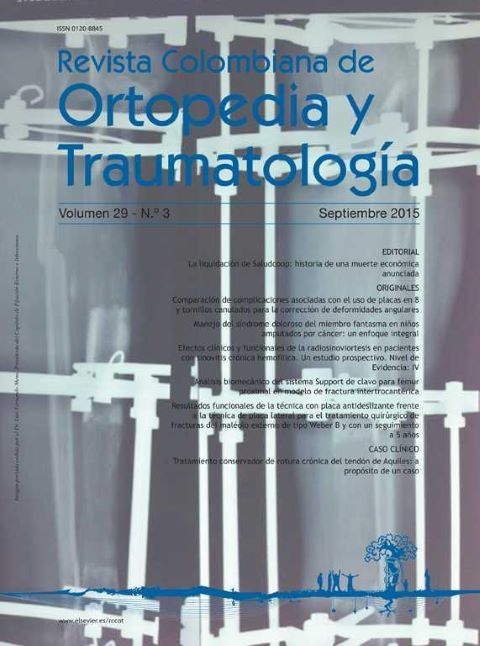Functional outcomes of posterior anti-glide plate versus lateral plate for the surgical treatment of Weber type B fractures of the lateral malleolus and a 5-year follow-up
DOI:
https://doi.org/10.1016/j.rccot.2016.02.007Keywords:
ankle fractures, anti-glide plate osteosynthesis, Weber BAbstract
Background: The aim of the study is to evaluate functional outcomes of Weber B ankle fractures by using anti-glide plate osteosynthesis, and compare them with lateral peroneal plate osteosynthesis.
Materials and methods: A prospective blinded uncontrolled clinical trial was conducted on a series of 70 patients. Anti-glide plate osteosynthesis patients were included in the study group, whereas lateral plate osteosynthesis patients were included into the control group. Both groups were followed up for a minimum of 60 months.
Results: A total of 40 patients (57.2%) were included into the study group, whereas 30 patients (42.8%) were included in the control group. Significant short and long-term differences were observed between groups in favour of the anti-glide plate osteosynthesis. In the long-term differences, it was noted that 18 patients of the control group required implant removal after 5 to 50 months of the open reduction and internal fixation.
Discussion: Anti-glide plate osteosynthesis is a cost-advantageous technique, as well as less morbid procedure than lateral plate osteosynthesis for managing Weber B ankle fractures.
Evidence level: II.
Downloads
References
Westerman R, Porter K. Ankle fractures in adults: an overview. Trauma. 2007;9:267-72. https://doi.org/10.1177/1460408607088292
Lesic A, Bumbasirevic M. Ankle fractures. Curr Orthop. 2004;18:232-44. https://doi.org/10.1016/j.cuor.2004.03.001
Cooper J. Management of simple and complex ankle fractures. Trauma. 2000;2:199-210. https://doi.org/10.1177/146040860000200304
Charlotte K, Edgren G, Jansson K, Wretenberg P. Epidemiology of adult ankle fractures in Sweden between 1987 and 2004. A population- based study of 91, 410 Swedish inpatients. Acta Ortopaedica. 2012;83:276-81. https://doi.org/10.3109/17453674.2012.672091
Hulsker C, Kleinveld S, Zonnenberg C, Hogervorst M, Van de Bekerom. Evidence-based treatment of open ankle fractures. Arch Orthop Trauma Surg. 2011;131:1545-53. https://doi.org/10.1007/s00402-011-1349-7
Lira J, Hernández C. Tratamiento quirúrgico temprano vs tardío en las fracturas agudas del tobillo y sus implicaciones económicas. Acta Ortop Mex. 2003;17:188-91.
Clare M. A rational approach to ankle fractures. Foot Ankle Clin Am. 2008;13:593-610. https://doi.org/10.1016/j.fcl.2008.09.003
Michelson J. Ankle fractures resulting from rotational injuries. J Am Acad Orthop Surg. 2013;11:403-12. https://doi.org/10.5435/00124635-200311000-00004
Richards P, Charran A, Singhal R, Mc Bride D. Ankle fractures and dislocations: A pictorial review. Trauma. 2013;15: 196-221. https://doi.org/10.1177/1460408612437304
Gehr J, Neber W, Hilsenbeck F, Friedl W. New concepts in the treatment of ankle joint fractures. The IP-XS (XSL) and IP-XXS (XXSL) nail in the treatment of ankle joint fractures. Arch Orthop Trauma Surg. 2004;124:96-103. https://doi.org/10.1007/s00402-003-0606-9
Thorngren K. Fractures in the elderly. Acta Orthop Scand. 1995;66:208-10. https://doi.org/10.3109/17453679509157694
Kosuge D, Mahadevan D, Chandrasenan J, Pugh H. Managing type II Lauge-Hansen supination external rotation ankle fractures: current orthopaedic practice. Ann R Coll Surg Engl. 2010;92:689-92. https://doi.org/10.1308/rcsann.2010.92.8.689
Payne R, Kinmont J, Moalypour S. Initial management of closed fracture-dislocations of the ankle. Ann R Coll Surg Engl. 2004;86:177-81. https://doi.org/10.1308/003588404323043300
Van den Bekerom MPJ. Diagnosing syndesmotic instability in ankle fractures. World J Orthop. 2011;2:51-6. https://doi.org/10.5312/wjo.v2.i7.51
Wuest T. Injuries to the distal lower extremity syndesmosis. J Am Acad Orthop Surg. 1997;5:172-81. https://doi.org/10.5435/00124635-199705000-00006
Ostrum R. Posterior plating of displaced weber b fibula fractures. J Orthop Trauma. 1996;10:199-203. https://doi.org/10.1097/00005131-199604000-00008
Winkler B, Weber B, Simpson L. The dorsal anti-glide plate in the treatment of Danis-Weber type-B fractures of the distal fibula. Clin Orthop Relat Res. 1990;259:204-9. https://doi.org/10.1097/00003086-199010000-00029
Lamontagne J, Blachut P, Broekhuyse H, O'Brien P, Meek R. Surgical treatment of a displaced lateral malleolus fracture: the anti-glide technique versus lateral plate fixation. J Orthop Trauma. 2002;16:498-502. https://doi.org/10.1097/00005131-200208000-00008
Schaffer J, Manoli A. The anti-glide plate for distal fibular fixation. J Bone Joint Surg. 1987;69A:596-604. https://doi.org/10.2106/00004623-198769040-00017
Holguín E, Herrera J, Reyes O, Mesa J. Resultados funcionales de la técnica de placa antideslizante versus técnica de placa lateral para el tratamiento quirúrgico de fractura del maléolo externo tipo Weber B. Rev Col Or Tra. 2008;22:117-21.
Peláez L, Reina E, Herrera JM. Luxofracturas de tobillo. Rev Latinoam Ortop Traumatol. 2014;3:61-78.
Peláez L, Reina E, Rangel C, Reyes O, Herrera J. Impacto de la rehabilitación precoz para la osteosíntesis con placa antideslizante en pacientes con fracturas de tobillo Weber B. Rev Col Or Tra. 2015;29:122-7. https://doi.org/10.1016/j.rccot.2016.03.005
Martinez N, Saldivar A, Sierra O, Jimenez E. Posterior anti-glide plate vs lateral plate to treat Weber type B ankle fractures. Acta Ortop Mex. 2004;18:39-44.
Ochoa LA. Experiencia y resultado en el tratamiento quirúrgico de las fracturas del tobillo tipo B con el principio antideslizante. Revista Venezolana de Cirugía Ortopédica y Traumatología. 2008;40:31-5.
Downloads
Published
How to Cite
Issue
Section
License
Copyright (c) 2024 Revista Colombiana de ortopedia y traumatología

This work is licensed under a Creative Commons Attribution 3.0 Unported License.




